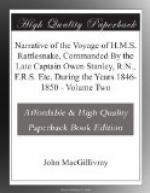The natives must have left the island either on account of its being now the turtling season, or else from the want of water. A small deep well behind the village, apparently the only one in the place, was almost entirely dried up. From the old man I procured the names of some of the neighbouring islands, and also a few other Kulkalega words which are so similar to those of the Kowrarega language as to corroborate Giaom’s assertion that both have many words in common. By way of illustration I may give a few examples. Thus muto, small bird; kudulug, dove; geinow, pigeon; kakur, egg; burda, grass; waraba, coconut; moda, enclosure round the huts.
At one place I saw indications of an upheaval of the northern side of the island in a bed of coral conglomerate six feet thick, with its raised wall-like edge towards the hill as if tilted up, and the remainder sloping down towards the sea. A similar appearance on a small scale exists on most of the coral islands which I have visited, but I had not before seen these sloping beds above the influence of the salt water, or at least beyond reach of the spray, still less supporting luxuriant vegetation, consisting in the present instance of a large extent of jungle, with trees often of great size, and a dense growth of underwood.
Productions of the island.
Among the natural productions of the island I may first allude to the large thickets of bamboo scattered along the base of the hill as the first new feature in the vegetation, and secondly, to the small Eucalypti growing between the hill and the brushes, as this is the most northerly limit of that Australian genus known to me. Among the trees of the brushes I may mention the Anacardium, or cashew nut, with large red acrid fruit, Mimusops kaukii, often attaining a great size, and a species of Bombax, or silk-cotton tree, from the trunk of one of which the canoe we saw upon the beach was being constructed.
Of birds the Australian quail, Torres Strait pigeon, and brown dove were plentiful, and afforded good sport to the shooters; Pitta strepitans (a handsome thrush-like bird of gaudy colours—red, green, blue and black) was heard calling in every brush and thicket. Several large lizards were seen; one of these, about four feet in length, perched upon the fence of one of the deserted huts, at first took so little notice of my approach that I refrained from shooting it, thinking it had been tamed. The colour of this lizard (Monitor gouldii) is a dull bluish green, spotted and variegated with yellow. It is much esteemed as food, and the skin is used for covering the warup or New Guinea drum.
Sue island.
December 7th.
In the morning a canoe, with seven men in it, came off to the ship from Sue Island, near which we were at anchor. At first they approached cautiously, holding up pieces of tortoise-shell, and making a great noise, shouting out, “kaisu (tortoise-shell) kapo-bue—kapo-buai—poud—poud,” etc., besides other words which were unintelligible, pointing at the same time to the island (which they called Waraber) as if inviting us to land.




